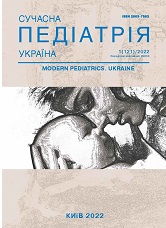Reproductive potential assesment of adolescent girls with gynecological pathology, born low to gestational weight
DOI:
https://doi.org/10.15574/SP.2022.121.42Keywords:
puberty, reproductive potential, low birth weight, menarcheAbstract
The timing of puberty depends on many genetic factors and external conditions: race and ethnicity, environmental characteristics, geographical location and even the nature of nutrition. Often the cause of functional delayed puberty is the syndrome of delayed fetal development.
Purpose - to study the main indicators of development and formation of the reproductive system of adolescent girls with gynecological pathology, born with a deficit of body weight.
Materials and methods. We examined 53 adolescent girls aged 13-18 years, who were divided into groups according to body weight at birth. Group 1 (main) - 26 girls born weighing less than 3000.0 grams. The second group (comparison) included 27 girls born with a body weight of 3000-3700.0 grams. The survey included analysis of anamnesis data, assessment of levels of physical and sexual development.
Results. The mean age of the subjects was 14.5±1.8 years [12.7; 16.3]. For girls who were born with low body weight, during puberty there was a lower dynamics of annual weight gain and average body weight compared to girls in group 2. In all age periods there was a significant lag in growth in the 1st group compared to the 2nd group. The growth deficit in 13-14 years was 3.5 cm, in 15-16 years - 3.7 cm, and in 17-18 years - 4.2 cm. The largest increase in the external size of the pelvis compared to the previous age period is observed in 15-16 years. In the 1st and 2nd groups of the transverse dimensions of the pelvis d.cristarum increases most intensively, slightly less - d.trochanterica. Analyzing the indicators of the main external dimensions of the pelvis, we can conclude that at the age of 13-14 and 15-16 years in girls of the 1st group, the size of the pelvis did not differ from the parameters in the 2nd group. However, in 17-18 years, all the external dimensions of the pelvis lagged behind the data in the 2nd group by an average of 1 cm, which indicates a tendency to form a narrow pelvis in girls born with low body weight. The average total score of sexual development in the 1st group in all studied age periods was significantly lower than in the 2nd.
Conclusions. For girls born with low body weight, there is a tendency to delay sexual development by the nature of pubic hair, but by the end of puberty, this feature is close to the parameters of peers born with normal body weight. Thus, by the age of 18, almost all girls born with normal body weight have a complete degree of secondary sexual characteristics, typical of women of childbearing age. While girls born with low body weight, there was a slowdown in the formation of secondary sexual characteristics in adolescence.
The research was carried out in accordance with the principles of the Helsinki declaration. The study protocol was approved by the Local ethics committee of the participating institution. The informed consent of the patient was obtained for conducting the studies.
No conflict of interest was declared by the authors.
References
Antipkin YuG, Marushko RV, Dudina EA. (2021). Evolution of infant mortality in Ukraine. Modern Pediatrics. Ukraine. 1 (113): 6-14. https://doi.org/10.15574/SP.2021.113.6
Bogdanova EA. (2011). Prakticheskaia hinekolohiia molodykh. Practical gynecology of young people. Moscow: Meditsinskaia kniha: 238.
Garces A, Perez W, Harrison MS, Hwang KS, Nolen TL, Goldenberg RL et al. (2020). Association of parity with birthweight and neonatal death in five sites: The Global Network's Maternal Newborn Health Registry study. Reprod. Health. 17 (3): 182. https://doi.org/10.1186/s12978-020-01025-3; PMid:33334362 PMCid:PMC7745358
Huraseva AB. (2010). Reproduktivnoie zdorovie zhenshchin, rodivshikhsia s poliarnymi znacheniiami massy tela. Reproductive health of women born with polar body weights. Extended abstract of Doctor's thesis. Volgograd: 40.
IOZDP. (2012). Sait Derzhavnoi ustanovy Instytut okhorony zdorovia ditei ta pidlitkiv Natsionalnoi akademii medychnykh nauk Ukrainy. Ranneie i pozdneie poiavleniie pervoi menstruatsii (menarhe) u devochek. Early and late appearance of the first menstruation (menarche) in girls.
Nazarenko LG, Nestertsova NS. (2016). Aspekty reproduktivnoho zdoroviia u zhenshchin s nizkoi i izbytochnoi massoi tela pri rozhdenii. Aspects of reproductive health in women with small and large for gestational age birth weight. Woman's Health. 10 (116): 53-55. https://doi.org/10.15574/HW.2016.116.53
Strashok LA, Buznytska OV. (2021). Anthropometric characteristics of adolescents with signs of metabolic syndrome. Modern Pediatrics. Ukraine. 5 (117): 35-40. https://doi.org/10.15574/SP.2021.117.35
Tuchkina IA, Dobrovolskaya LA, Tuchkina MYu. (2016). Kliniko-diahnosticheskiie aspekty pervichnoi dismenorei v podrostkovom vozraste. Clinical and diagnostic aspects of primary dysmenorrhea in adolescence. Medicine (Almaty). 6 (168): 51-56.
Tuchkina IO, Vyhivska LA, Maltsev HV, Blahoveshchenskyi YeV, Demidenko OD, Rohachova NSh et al. (2018). Zatrymka rostu vnutrishnoutrobnoho ploda: metodychni vkazivky dlia likariv-interniv, likariv akusheriv-hinekolohiv, dytiachykh hinekolohiv, pediatriv, simeinykh likariv. Intrauterine growth re-tardation: guidelines for interns, obstetricians and gynecologists, pediatric gynecologists, pediatricians, family physicians. Kharkiv: KhNMU: 40.
Zhylka NJ, Myronjuk IS, Slabkyi GO. (2018). Characteristics of Some Indicators of Reproductive Health of the Female Population of Ukraine. Wiadomosci Lekarskie (Poland). 71 (9): 1803-1808.
Downloads
Published
Issue
Section
License
Copyright (c) 2022 Modern pediatrics. Ukraine

This work is licensed under a Creative Commons Attribution-NonCommercial 4.0 International License.
The policy of the Journal “MODERN PEDIATRICS. UKRAINE” is compatible with the vast majority of funders' of open access and self-archiving policies. The journal provides immediate open access route being convinced that everyone – not only scientists - can benefit from research results, and publishes articles exclusively under open access distribution, with a Creative Commons Attribution-Noncommercial 4.0 international license (СС BY-NC).
Authors transfer the copyright to the Journal “MODERN PEDIATRICS. UKRAINE” when the manuscript is accepted for publication. Authors declare that this manuscript has not been published nor is under simultaneous consideration for publication elsewhere. After publication, the articles become freely available on-line to the public.
Readers have the right to use, distribute, and reproduce articles in any medium, provided the articles and the journal are properly cited.
The use of published materials for commercial purposes is strongly prohibited.

